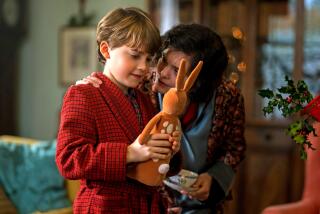She’s Wild in the Streets, Feasting on the Foliage of Freedom
- Share via
The most famous of all post-World War II Rabbits ran in the dark of night, toward his primal past and away from an alcoholic wife named Janice and the haunting ghost of a once-deadly jump shot.
That Rabbit--Rabbit Angstrom, courtesy of novelist John Updike--was searching for the meaning of modern manhood and a hole deep enough to bury his modern angst .
On Jan. 17, 1994, a lesser-known Northridge rabbit broke free under cover of darkness and amid the confusion of a pounding earthquake. Seventeen months later, the three-pound white-and-brown cottontail is still running--well, OK, hopping--on an equally epic quest. Like Buck, the dog in Jack London’s “Call of the Wild,” Hippity the freedom-seeking rabbit is relearning the skills of her wild ancestors.
Buck escaped the drudgery of hauling heavy sleds across the frozen Klondike to lead the free life, wolf-style. Hippity--or Princess, as onetime owner Donald Mills called her in captivity--moves stealthily among whizzing traffic and ill-tempered neighborhood cats, through the suburban jungle of Northridge.
When her hutch collapsed in the Northridge quake, Hippity bolted for freedom--leaving her mother to die in an unfriendly dog’s jaws--and has lived wild ever since, roaming the neighborhood just south of Cal State Northridge for handouts from her admirers but refusing to be recaptured.
“She’s smart now,” said Chuck Gahagen, who has befriended the rabbit well enough to hand-feed her carrots and cashews, if not pet her. She “has escaped the clutches of other wild beasts.”
Hippity had a pained upbringing and an apparently genetic predisposition to resist a life in custody.
Her parents were hauled into the Wildlife Waystation in Angeles National Forest a couple years back. The folks there--who blithely host elephants and lions--hadn’t the facilities for two rabbits and told Mills’ wife, a volunteer at the facility: “We’ll probably have to feed them to the snakes.”
So the Millses snatched the two from the reptilian jaws of death and brought them to Northridge.
“The very next day I took the dad to the vet’s to have him fixed,” Mills said. “But it was already too late.”
About two weeks later, Hippity and three siblings were born. Well, six rabbits was four too many. So, Mills said, he loaded up the babies to take to a woman in Topanga, who dedicates an entire floor of her home to a herd of Oryctolagus cuniculus . Hippity took one look at the carrier box where her siblings waited, leaped from Mills’ arms and bolted for the woods.
The Mills family soon recaptured the escapee, and although her brothers and sister had been turned over to the rabbit lady for safekeeping, Hippity was returned to the hutch with her parents.
But the adventures of the furry free spirit with the spotted nose and one flopping ear were far from over.
In the 4 a.m. darkness of Jan. 17, the earth bucked and the cinder-block walls of the Mills home crumbled, as did the cinder-block fence keeping the three rabbits in the back yard. As they explored their new world, a neighbor’s dog killed Hippity’s mother.
“The father was heartbroken,” Mills said. “They were so close. They used to lie together in the grass, their heads almost touching.”
Grieving or not, Hippity lit out for the territories.
Now, there are some points about rabbits--real and mythical--that are essential to the understanding of any serious rabbit quest.
First, they are fast creatures (ask the tortoise), capable of reaching 18 m.p.h. over short distances. The owner of a good pair of hind legs--much larger and more muscular than the front--can leap as far as 10 feet in a single bound, according to the World Book encyclopedia.
Some sub-Saharan tribes tell fables of a cunning hare believed to be the ancestor of Br’er Rabbit. Then there is the White Rabbit, conjured with the help of lysergic acid by Grace Slick and possible dementia by Lewis Carroll.
Hippity is a rabbit worthy of this prestigious family tree.
After her escape, she initially laid low, perhaps getting a feel for the land and trying to make sense of traffic patterns. But she soon reappeared, infrequently at first, for the quick-hit food run, disappearing again, occasionally with a neighborhood cat on her heels.
At the Gahagen house, a block and a half away from the Mills place, she came for snacks and shade. Sometimes she’d show up every four or five days and then vanish for a month, or even two.
*
Chuck and Jean Gahagen eventually tempted her into hand feedings with carrots and, lacking peanuts at first, cashews. (For a rebel rabbit on a vision quest, however, nothing tastes as sweet as filched food, and the small, leafy plants outside the Gahagen house are gnawed almost to the ground.) She comes to an open, upturned palm, but knows that palm-down means a pat, or maybe grab, and shies away.
“None of us have been fast enough to touch her,” says Jean. “She’s gone.”
Mills, who takes a pocket full of peanuts when he goes for a walk in case he runs into her, managed to grab hold of his liberated bunny once. Like a wolf that will chew its leg off to escape a trap, Hippity left him with a fistful of fur and feelings of guilt.
“That must have really hurt,” he says.
Seeming to sense the import of the Hipster’s journey, neither the Gahagens nor the Millses are eager to “deprive her of her liberty,” as Jean puts it.
Rabbit, Run.
More to Read
Sign up for Essential California
The most important California stories and recommendations in your inbox every morning.
You may occasionally receive promotional content from the Los Angeles Times.











